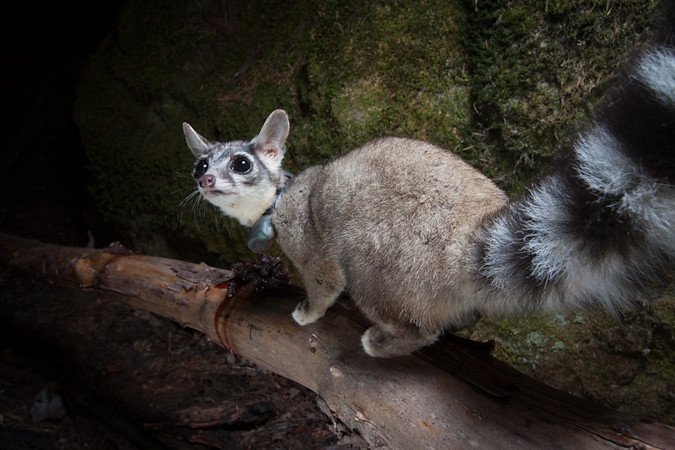OSU, partners’ study provides rare glimpse of the ringtail, an important but poorly understood predator

CORVALLIS, Ore. (KTVZ) – Secretive species can pose special conservation challenges simply because they are so skilled at staying under the radar that researchers have uncovered comparatively little about their basic needs.
One such species is the ringtail, a relative of the raccoon that has cultural significance to many Indigenous peoples in North America.
A collaboration among scientists from Oregon State University, the Hoopa Valley Tribe, Penn State and Cal Poly Humboldt has shed light new on the cat-like animal known for its large eyes and fluffy, striped tail.
The nocturnal carnivore, known scientifically as Bassariscus astutus, usually weighs between 1 and 2 pounds and is around 24 inches long including its tail.
Ringtails use the cavities of living trees or standing dead ones, called snags, to rest, sleep, avoid bad weather, hide from predators and make dens to raise their young.
The research, conducted on the Hoopa Valley Reservation northeast of Eureka, California, found ringtails selected tree cavities in mature and older forests, as well as in younger forests with some older trees still present, rather than oak woodlands or other more open areas.
“Ringtails were also less likely to rest closer to streams,” said study co-author Sean Matthews, a wildlife ecologist with OSU’s Institute for Natural Resources. “And we found the presence of fishers, another charismatic, cat-like carnivore known to compete with ringtails for resources, did not influence where ringtails chose to rest.”
These findings differ from what is known ringtails in other portions of their range, Matthews added, and offer important guidance for forest managers seeking to conserve trees with cavities used by ringtails.
Medium-sized carnivores like the ringtail are under pressure because of a wide-scale loss of habitat, particularly oak woodlands, Matthews said, “and there are so many unknowns about fundamental aspects of their ecology.”
“They’re definitely a species of conservation concern in California and Oregon,” he said. “Gaps in what we know about their life history traits, habitat preferences, species interactions and population-level threats inhibit effective population monitoring, habitat management and conservation planning. Learning more about ringtails on the Hoopa Valley Reservation will assist the Tribe in their forest management and restoration efforts.”
Also referred to as ring-tailed cats or miners cats, they were kept in mining camps to control rodents but are not a member of the feline family. Ringtails live from southwestern Oregon to northern Mexico, with their range stretching east to include southern Nevada, Utah, Colorado, Texas, Arizona, New Mexico, Oklahoma and Kansas.
Ringtails are superlative climbers, capable of ascending vertical walls as well as trees and cacti. Their hind feet rotate 180 degrees, making for a strong grip during descent, and they have excellent eyesight and hearing.
Wild ringtails typically live between six and nine years; their lifespan is longer in zoological settings.
In addition to tree cavities, ringtails will make dens in rock crevices, tree hollows and other animals’ abandoned burrows – and also in mine shafts, abandoned buildings and, occasionally, the attic of an occupied home.
Ringtails eat insects, lizards, snakes, small mammals, birds and bird eggs. They will eat fruit too.
Hoopa Tribal Forestry helped fund this study, which was published in BioOne. Traditionally, singers performing in the Hoopa White Deer Skin Dance Ceremony would wear skirts made partially from ringtail hides. The skin of a white deer is a rare and protective heirloom among the Hoopa people, with skins passed down from generation to generation.
The Norcross Wildlife Foundation, the Western Section of the Wildlife Society, Thomas and Doris Montgomery, the Marin Rod and Gun Club, the Stockton Sportsmen’s Club and the Humboldt Area Foundation also supported the research.



